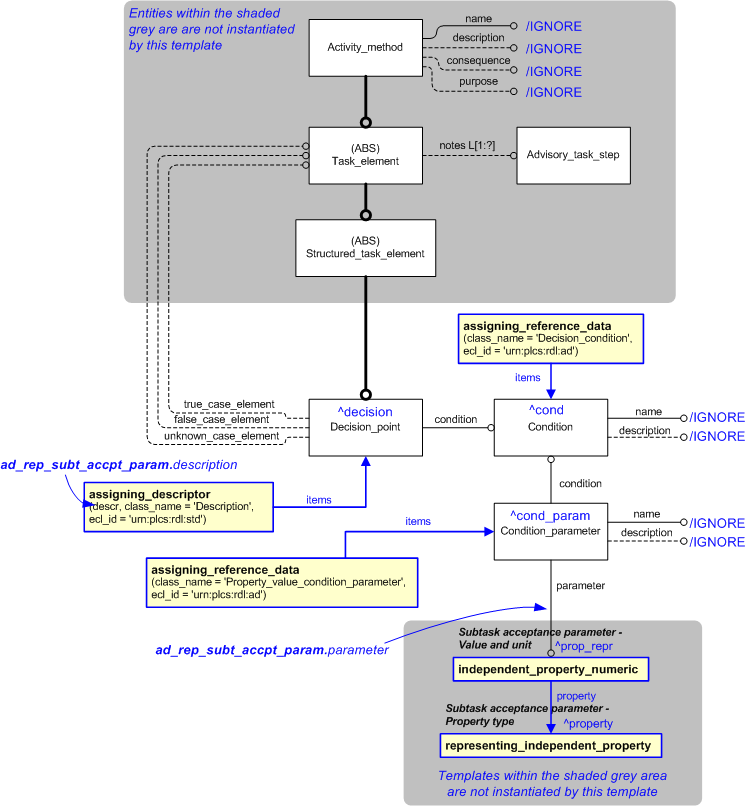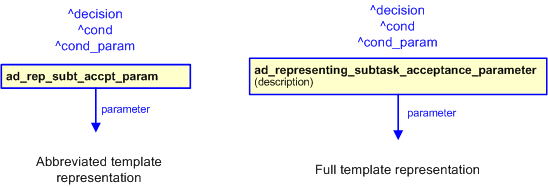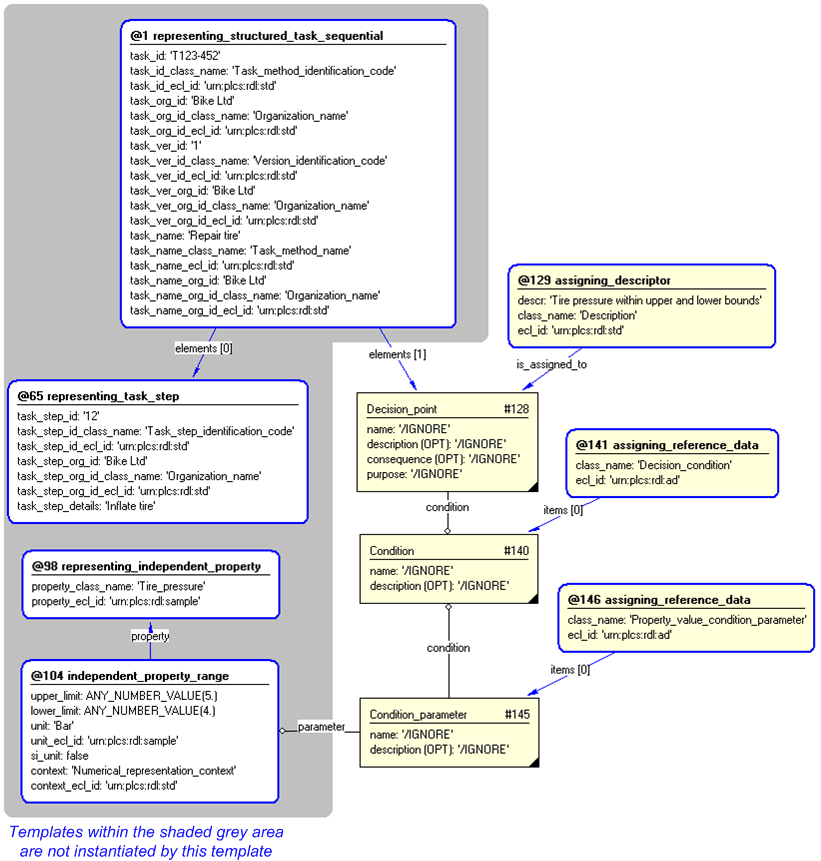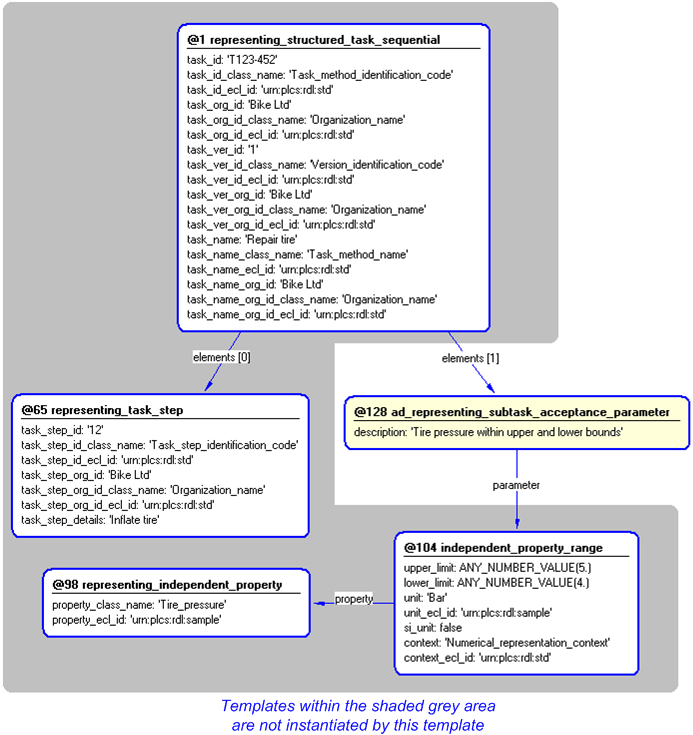
| Template:— ad_representing_subtask_acceptance_parameter (ad_rep_subt_accpt_param) Context:— Aerospace_and_Defense |
Date: 2011/04/20 15:36:49 Revision: 1.2 |
This section specifies the template ad_representing_subtask_acceptance_parameter.
NOTE The template has been defined in the context of Aerospace_and_Defense. Refer to the business context for details of related templates.
NOTE An explanation of a template and the associated instantiation path is provided in the Template overview section.
This template describes how to represent an S3000L subtask acceptance parameter.


target
is the parameter to which the
Decision_point
is bound.
target
is the parameter to which the
Condition
is bound.
target
is the parameter to which the
Condition_parameter
is bound.
| Entity in path | Value | Inherited from |
| Condition.name | '/IGNORE' | — |
| Condition.description | '/IGNORE' | — |
| Condition_parameter.name | '/IGNORE' | — |
| Condition_parameter.description | '/IGNORE' | — |
| Decision_point.name | '/IGNORE' | Activity_method.name |
| Decision_point.description | '/IGNORE' | Activity_method.description |
| Decision_point.consequence | '/IGNORE' | Activity_method.consequence |
| Decision_point.purpose | '/IGNORE' | Activity_method.purpose |

#2 = TASK_METHOD('/IGNORE','/IGNORE','/IGNORE','/IGNORE',()); #4 = IDENTIFICATION_ASSIGNMENT('T123-452','/IGNORE','/IGNORE',(#2)); #6 = CLASSIFICATION_ASSIGNMENT(#7,(#4),'/IGNORE'); #7 = EXTERNAL_CLASS('/NULL','Task_method_identification_code','/IGNORE',#8); #8 = EXTERNAL_CLASS_LIBRARY('urn:plcs:rdl:std','/IGNORE'); #11 = ORGANIZATION('/IGNORE','/IGNORE'); #13 = IDENTIFICATION_ASSIGNMENT('Bike Ltd','/IGNORE','/IGNORE',(#11)); #15 = CLASSIFICATION_ASSIGNMENT(#16,(#13),'/IGNORE'); #16 = EXTERNAL_CLASS('/NULL','Organization_name','/IGNORE',#8); #18 = ORGANIZATION_OR_PERSON_IN_ORGANIZATION_ASSIGNMENT(#11,'/IGNORE',(#4)); #20 = CLASSIFICATION_ASSIGNMENT(#21,(#18),'/IGNORE'); #21 = EXTERNAL_CLASS('/NULL','Owner_of','/IGNORE',#8); #24 = IDENTIFICATION_ASSIGNMENT('Repair tire','/IGNORE','/IGNORE',(#2)); #26 = CLASSIFICATION_ASSIGNMENT(#27,(#24),'/IGNORE'); #27 = EXTERNAL_CLASS('/NULL','Task_method_name','/IGNORE',#8); #31 = ORGANIZATION('/IGNORE','/IGNORE'); #33 = IDENTIFICATION_ASSIGNMENT('Bike Ltd','/IGNORE','/IGNORE',(#31)); #35 = CLASSIFICATION_ASSIGNMENT(#36,(#33),'/IGNORE'); #36 = EXTERNAL_CLASS('/NULL','Organization_name','/IGNORE',#8); #38 = ORGANIZATION_OR_PERSON_IN_ORGANIZATION_ASSIGNMENT(#31,'/IGNORE',(#24)); #40 = CLASSIFICATION_ASSIGNMENT(#41,(#38),'/IGNORE'); #41 = EXTERNAL_CLASS('/NULL','Owner_of','/IGNORE',#8); #43 = TASK_ELEMENT_SEQUENCE('/IGNORE','/IGNORE','/IGNORE','/IGNORE',$,(#66,#128)); #44 = TASK_METHOD_VERSION('/IGNORE','/IGNORE','/IGNORE','/IGNORE',#43,#2); #46 = IDENTIFICATION_ASSIGNMENT('1','/IGNORE','/IGNORE',(#44)); #48 = CLASSIFICATION_ASSIGNMENT(#49,(#46),'/IGNORE'); #49 = EXTERNAL_CLASS('/NULL','Version_identification_code','/IGNORE',#8); #53 = ORGANIZATION('/IGNORE','/IGNORE'); #55 = IDENTIFICATION_ASSIGNMENT('Bike Ltd','/IGNORE','/IGNORE',(#53)); #57 = CLASSIFICATION_ASSIGNMENT(#58,(#55),'/IGNORE'); #58 = EXTERNAL_CLASS('/NULL','Organization_name','/IGNORE',#8); #60 = ORGANIZATION_OR_PERSON_IN_ORGANIZATION_ASSIGNMENT(#53,'/IGNORE',(#46)); #62 = CLASSIFICATION_ASSIGNMENT(#63,(#60),'/IGNORE'); #63 = EXTERNAL_CLASS('/NULL','Owner_of','/IGNORE',#8); #66 = TASK_STEP('/IGNORE','/IGNORE','/IGNORE','/IGNORE',$); #68 = IDENTIFICATION_ASSIGNMENT('12','/IGNORE','/IGNORE',(#66)); #70 = CLASSIFICATION_ASSIGNMENT(#71,(#68),'/IGNORE'); #71 = EXTERNAL_CLASS('/NULL','Task_step_identification_code','/IGNORE',#8); #75 = ORGANIZATION('/IGNORE','/IGNORE'); #77 = IDENTIFICATION_ASSIGNMENT('Bike Ltd','/IGNORE','/IGNORE',(#75)); #79 = CLASSIFICATION_ASSIGNMENT(#80,(#77),'/IGNORE'); #80 = EXTERNAL_CLASS('/NULL','Organization_name','/IGNORE',#8); #82 = ORGANIZATION_OR_PERSON_IN_ORGANIZATION_ASSIGNMENT(#75,'/IGNORE',(#68)); #84 = CLASSIFICATION_ASSIGNMENT(#85,(#82),'/IGNORE'); #85 = EXTERNAL_CLASS('/NULL','Owner_of','/IGNORE',#8); #88 = DOCUMENT_ASSIGNMENT(#93,#66,'/IGNORE'); #90 = CLASSIFICATION_ASSIGNMENT(#91,(#88),'/IGNORE'); #91 = EXTERNAL_CLASS('/NULL','Description','/IGNORE',#8); #93 = DOCUMENT('/IGNORE','/IGNORE','Inflate tire'); #95 = CLASSIFICATION_ASSIGNMENT(#96,(#93),'/IGNORE'); #96 = EXTERNAL_CLASS('/NULL','Descriptor','/IGNORE',#8); #99 = INDEPENDENT_PROPERTY('/IGNORE','/IGNORE','/IGNORE'); #101 = CLASSIFICATION_ASSIGNMENT(#102,(#99),'/IGNORE'); #102 = EXTERNAL_CLASS('/NULL','Tire_pressure','/IGNORE',#103); #103 = EXTERNAL_CLASS_LIBRARY('urn:plcs:rdl:sample','/IGNORE'); #105 = INDEPENDENT_PROPERTY_REPRESENTATION('/IGNORE',#99,#107,'/IGNORE'); #107 = PROPERTY_VALUE_REPRESENTATION('/IGNORE','/IGNORE','/IGNORE',#108,(#113)); #108 = NUMERICAL_REPRESENTATION_CONTEXT('/IGNORE','/IGNORE',$,$); #110 = CLASSIFICATION_ASSIGNMENT(#111,(#108),'/IGNORE'); #111 = EXTERNAL_CLASS('/NULL','Numerical_representation_context','/IGNORE',#8); #113 = VALUE_RANGE('/IGNORE',#122,#115); #115 = NUMERICAL_ITEM_WITH_UNIT('/IGNORE',#116,ANY_NUMBER_VALUE(5.)); #116 = UNIT('/IGNORE',false); #118 = CLASSIFICATION_ASSIGNMENT(#119,(#116),'/IGNORE'); #119 = EXTERNAL_CLASS('/NULL',$,'/IGNORE',#8); #122 = NUMERICAL_ITEM_WITH_UNIT('/IGNORE',#123,ANY_NUMBER_VALUE(4.)); #123 = UNIT('/IGNORE',false); #125 = CLASSIFICATION_ASSIGNMENT(#126,(#123),'/IGNORE'); #126 = EXTERNAL_CLASS('/NULL','Bar','/IGNORE',#103); #128 = DECISION_POINT('/IGNORE','/IGNORE','/IGNORE','/IGNORE',$,#140,$,$,$); #130 = DOCUMENT_ASSIGNMENT(#135,#128,'/IGNORE'); #132 = CLASSIFICATION_ASSIGNMENT(#133,(#130),'/IGNORE'); #133 = EXTERNAL_CLASS('/NULL','Description','/IGNORE',#8); #135 = DOCUMENT('/IGNORE','/IGNORE','Tire pressure within upper and lower bounds.'); #137 = CLASSIFICATION_ASSIGNMENT(#138,(#135),'/IGNORE'); #138 = EXTERNAL_CLASS('/NULL','Descriptor','/IGNORE',#8); #140 = CONDITION('/IGNORE','/IGNORE'); #142 = CLASSIFICATION_ASSIGNMENT(#143,(#140),'/IGNORE'); #143 = EXTERNAL_CLASS('/NULL','Decision_condition','/IGNORE',#144); #144 = EXTERNAL_CLASS_LIBRARY('urn:plcs:rdl:ad','/IGNORE'); #145 = CONDITION_PARAMETER('/IGNORE','/IGNORE',#140,#105); #147 = CLASSIFICATION_ASSIGNMENT(#148,(#145),'/IGNORE'); #148 = EXTERNAL_CLASS('/NULL','Property_value_condition_parameter','/IGNORE',#144);

© OASIS 2010 — All rights reserved